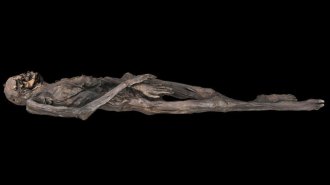Skulls attest to Iron Age scalping
About 2,500 years ago, the Greek historian Herodotus described, in gory detail, how Scythian warriors of central Asia scalped vanquished foes. Archaeologists now have identified the first hard evidence of that practice. According to their study, four previously unearthed adult male skulls, now housed in two Russian museums, come from Scythians whose scalps were removed after they were killed in battle.
An intermittent trail of incisions runs, ear-to-ear, horizontally across the back of each of the skulls, says Eileen M. Murphy of Queens University of Belfast, Northern Ireland. Metal tools made the marks during a process in which skin was peeled off the back and top of the head, she holds. Three of the skulls came from a Scythian cemetery. The fourth skull came from a mummified body discovered in a tomb of Scythian royals. Both sites are in southern Siberia.
Analysis of the skeletons belonging to the skulls indicates that these individuals died of sword and battle-ax wounds, Murphy and her colleagues report in the January American Journal of Archaeology.
Additional examinations of skeletons at Russian sites will probably support Herodotus description of scalping as a widespread Scythian practice, the researchers add. But the historian may have been wrong in calling Scythians cannibals, Murphy contends. Prior skeletal evidence suggests only that Scythians sometimes removed the flesh from the dead bodies of comrades as part of burial rituals, a fairly common practice in the ancient world.







